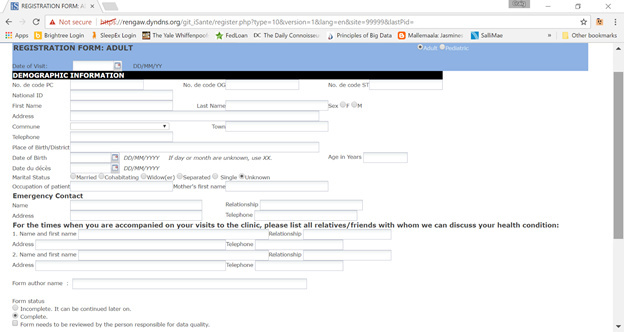Hi Everyone,
I have a spike to define the differences between registering patients using the xforms module and the registration app. We’re trying to identify the best path forward for the implementation of iSantePlus in Haiti. Can you confirm that these statements are correct?
End User Functionality: There are core differences between the end user functionality of each module.
Registering Patients
- The Xforms module redirects to the Xform when you click the button to register a patient, then redirects to the clinician facing dashboard once the form has been submitted. The xform page is a standard UI page.
- The Registration app module redirects to a Simple UI form that’s displayed one field at a time. Once the form is complete, it redirects to the clinician facing dashboard. It’s also possible to build off the work of PIH and redirect to a registration summary dashboard.
- Both modules allow you to store registration information as encounters and observations as well as person attributes. Additionally, they allow you to collect multiple identifiers
- The Registration App performs a live search for duplicate patients when you type in the patient name. I don’t think this feature is available in the xforms module (@dkayiwa, please correct me if this isn’t true). Subsequently, it appears that there has been a spike to integrate this list with a Master Patient Index, allowing users to search both the local database and the Master Patient Index for duplicates during the registration process.
- The Xforms module searches for duplicates after the form is submitted and presents an error if the registered patient appears to be a duplicate.
Editing Patients
- Both modules allow you to edit patient registration information by clicking an area in the Patient Header of the Clinician Facing Dashboard
- The Xforms module redirects to the full xform, populating the information that has already been entered.
- The Registration App redirects you to the SimpleUI for a specific section. So, if you click the “Edit” hyperlink next to the patient’s name, you will be redirected to the demographics section of the registration form. Right now, there isn’t a clear way to edit all patient demographic information on a single screen with the registration app. If you have additional sections to add during the registration process, you need to create a link to edit those sections somewhere on the clinician facing dashboard (this is also a good reason to follow the PIH registration summary dashboard).
Configuration: Xforms: You have to create the xform in the form designer and Set the global property “xforms.usePatientXform” = true causing a redirect during patient registration and edit.
Registration App: Create an app.json to configure the registration app and make sure the redirectURLs point to the right place. You also have to override the edit button in the clinicianfacing dashboard to the sections point to the appropriate section in your registration app.
Craig
FYI @dkayiwa, @ball, @mogoodrich, @jamesfeshner, @arbaughj, @ssmusoke, @jmaxy
